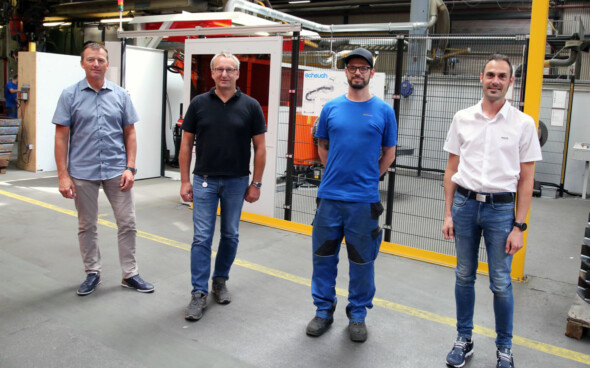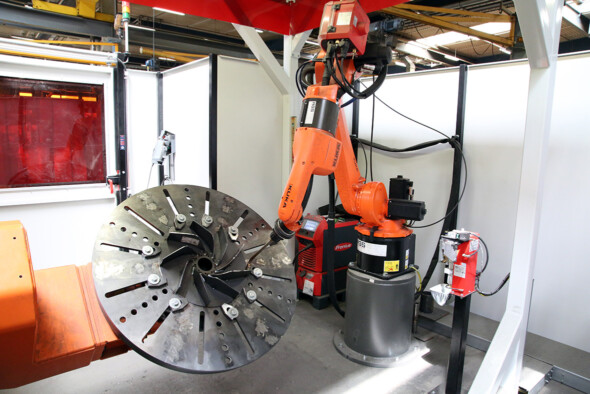Highly productive robot welding from a batch size of 1
At Scheuch COMPONENTS, fully automatic welding of different components in a batch size of 1 is not just a vision – it is already reality. At the headquarters in Aurolzmünster, Upper Austria, a new robotic welding cell from AGS and Kuka masters the daily requirements of order-based “just-in-time” production with flying colours while ensuring maximum productivity and consistently high welding quality.
The company’s production facilities feature state-of-the-art equipment to ensure that it can live up to its own exceptionally high production quality standards. Alongside an innovation centre with its own research and development department as well as an in-house test site featuring numerous test stands, Scheuch COMPONENTS also boasts cutting-edge machinery.
With an annual welding wire consumption of around 46 tonnes, there is no doubt that welding is one of the company’s central production processes. Around 50 highly trained welders carry out their work reliably in a three-shift system every day. The only place where there was potential for optimization was in the area of welding automation, as the existing 16-year-old welding robot system was becoming outdated.
In order to ensure that the company was in the best possible position for the future, Scheuch decided to invest in a brand-new high-tech welding robot cell from AGS-Engineering. “All of our production here is order-based. With everything individually tailored to the relevant customer solution, this means we are welding the majority of the components in a batch size of 1. With the new welding solution, we are now able to automate single-item production for a relatively broad selection of parts in a cost-effective manner,” says Hubert Puttinger, the production manager, succinctly. Furthermore, increasing the degree of automation will help to compensate for the shortage of skilled workers that the company is currently experiencing – a crucial factor when it comes to ensuring long-term success.
The contract for the welding robot cell was awarded to AGS-Engineering GmbH, which was founded by Walter Kohlbauer as a one-man operation in 2003 and now has 47 employees. The company offers customized automation solutions for special machines, production lines, robot cells as well as industrial control technology for machines and buildings. “When things get complicated and other providers lose their nerve, that’s where we come in. As well as planning system engineering, electrical systems and switch cabinet technology and establishing connections to higher-level control systems or quality management systems, we can also develop customer-specific software and create applications for industrial image processing,” explains the managing director of AGS.
For projects involving robot technology, the company relies almost entirely on the high product quality and comprehensive technical expertise of Kuka. “Once again, collaborating with Kuka worked perfectly for this project. In particular, the feasibility analyses and welding tests in the Kuka application centre in Steyregg were incredibly important for the system implementation,” says Kohlbauer. Following the preliminary acceptance process in the AGS assembly hall, the robot cell was finally put into operation in February this year.
“The comprehensive package completely won us over. From the first discussion, it was clear that AGS had many years of experience and extensive knowledge regarding the implementation of automation solutions,” says Puttinger, who also saw the physical proximity between Scheuch COMPONENTS and AGS – both based in Aurolzmünster – as a significant advantage, particularly when it came to service.
Picture (f.l.t.r): Walter Kohlbauer (AGS), Hubert Puttinger, Daniel Fink (both Scheuch COMPONENTS) and Stefan Pichler (AGS)
The components are welded by the Kuka welding robot KR 8 R2100 arc HW, which is connected to a Fronius TPS 400i Pulse welding power source. “With its hollow wrist for integrating the cable and hose assembly, its slim design and a range of 2,100 mm, this robot is ideal for welding Scheuch parts,” says Kohlbauer.
A burner cleaning station including burner measurement as well as additional Kuka software packages ensure maximum process reliability and quality. “Thanks to tactile technology, arc sensors and predefined weave patterns, these software tools are constantly correcting the welding line in real time and can therefore compensate for component tolerances of up to 5 mm automatically,” says Kohlbauer.
The operator merely has to clamp the pre-tacked component into the clamping device on the Kuka KP5-V2S2V workpiece positioner and the positioner will then move it into the welding area of the robot. While welding is taking place on one side of the positioner, the next component can be loaded on the other side.
The Delfoi Arc offline programming system is used to create the relevant welding programme for the robot during the preparation phase. The Scheuch team has mainly been using the new robot system to weld blade wheels for fans: “Each of these impellers varies with regard to height, diameter, blade angle and radius. Thanks to the offline programming option – and with no time-consuming teaching processes required for the robot – the new welding cell ensures cost-effective welding production and maximum productivity even in a batch size of 1.”
“The software is very easy to use – I was new to offline programming but I picked it up quickly,” says Daniel Fink, a welding robot programmer at Scheuch COMPONENTS. Highly practical, prefabricated templates reduce the programming time significantly.
This is demonstrated by a practical comparison with manual welding: “An impeller that takes a welder around two hours to produce can be welded by the robot in 38 minutes. When you factor in the programming time of around 30 minutes, we are looking at a time saving of almost 50 %,” says Daniel Fink. Furthermore, additional time can be saved in the case of recurring parts as there is no need to carry out the programming again.
Furthermore, simulations and path checks – which check each individual welding position within seconds – detect potential collisions in advance.
In addition to blade wheels for fans, the Scheuch team is also using the new robot welding cell to produce various rotary valves including rotors as well as components for screw conveyors. “We are adding new components every day. I have no doubt that, in the future, we will be able to use the system to weld over 500 different parts in a cost-effective manner,” says Hubert Puttinger, before going on to describe other benefits of robot welding: “A robot welder will always produce the same consistently high level of quality. And because robots can work without pausing, the workpiece is heated and cooled evenly – minimizing warpage on the component.”
The production manager has a clear vision – not just one, but several welding robot cells hard at work in the Scheuch COMPONENTS production hall, ensuring high levels of productivity and the best possible quality: “In order to remain competitive, we need to introduce more automation into our processes. The system from AGS and Kuka perfectly demonstrates the fact that automation and a batch size of 1 do not need to be mutually exclusive.”


